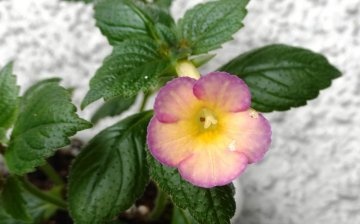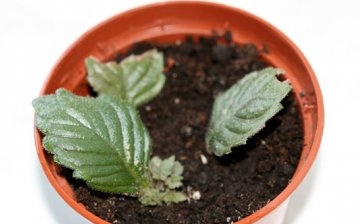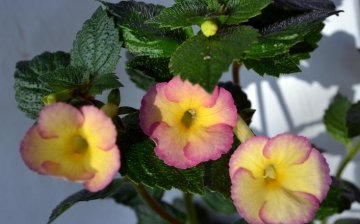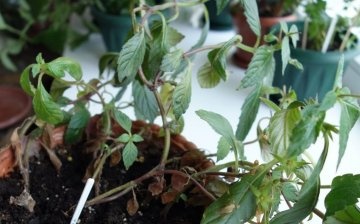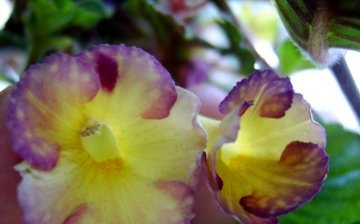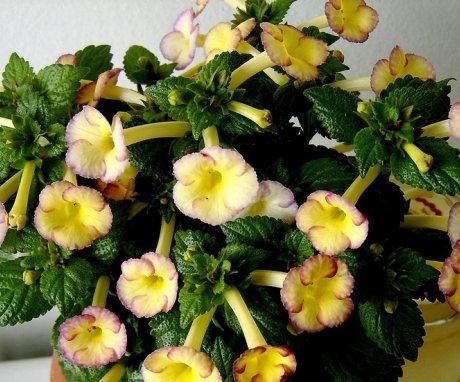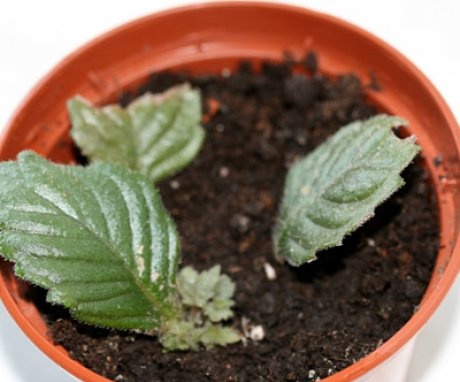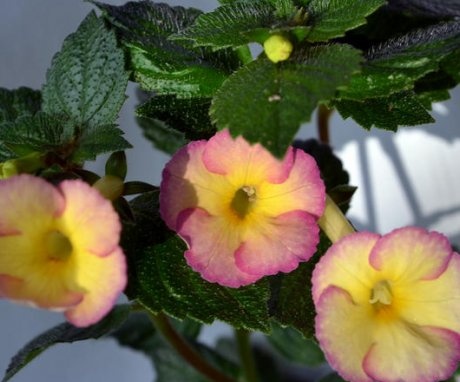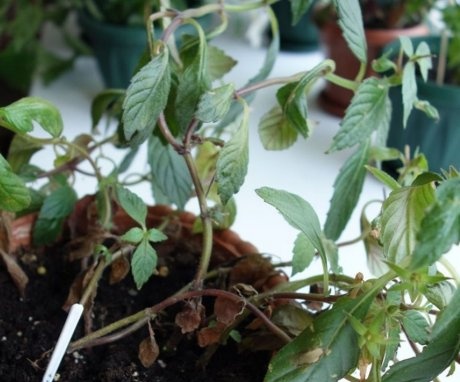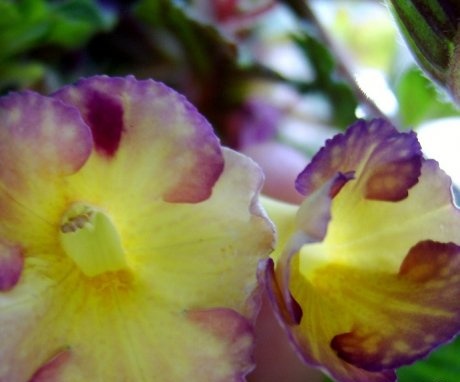Ahimenes Honey Queen: all about growing a potted flower
Indoor flower Akhimenes belongs to the Gesneriev family. This tropical plant is prized by gardeners for its abundant flowering and beautiful, albeit small, flowers that cover the bush.
Content:
- Features of an indoor flower
- Reproduction methods and rules
- Growing achimenes
- Resting care
- Achimenes transplant
Features of an indoor flower
Ahimenes is a herbaceous bush with a large number of semi-drooping branches and flowers. The gramophones of flowers keep on the branches for a long time. The leaves are serrated, with a glossy surface, covered with hard hairs. The color depends on the variety and can be light green, dark green, purple, burgundy, multi-colored. Among the varieties of achimenes there are erect and ampelous.
Flowers are funnel-shaped, can be double and simple.
In some varieties, the petals are folded back into the flower. They grow singly or are located on shoots in groups of up to 5 pieces each. The achimenes variety Honey Queen has green leaves and a bright yellow flower center. Closer to the petals, it turns pale, and radial brown shadows appear.
Towards the edge, the yellow color turns into a light pink-violet border. On it you can see rounded yellow spots. Shows the entire color palette in a shaded place, protected from direct sunlight.
Reproduction methods and rules
Achimenes achimenes Honey Queen is propagated in several ways:
- Seeds... Seed propagation is the most difficult possible way. At the same time, the properties of the mother plants are not preserved, but there is an opportunity to develop a new variety. The seeds are allowed to ripen in seed pods located on the stems of the plant after flowering. They ripen for 2 months. Small seeds are collected, in February they are sown on top of a loose substrate, poured into dishes with large drain holes... Do not sprinkle with earth. Sprayed. Moisten the soil, cover with glass or polyethylene. Install in a place protected from sunlight. The temperature is maintained at 24 ° C. Water through the pallet. The first shoots appear in 2 weeks. When they grow up dive at a distance of 7 cm from each other. After 2 months, they are transplanted into separate pots.
- Cuttings... The plant reproduces well by rooting cuttings. To do this, take a shoot 5-7 cm long, plant it in a bowl with loose soil, consisting of sand and leafy soil. Sprinkle over, cover with a glass jar or cut plastic bottle. Ventilate so that there is no stagnation of air in the area of the escape. When young leaves appear, they begin to remove the shelter, first for a while, and soon for good. After a few weeks, they are transplanted into soil for adult plants.
- By dividing the bush. To propagate achimenes by dividing the roots, during transplantation, the plants are planted in different pots.
Growing achimenes
Achimenes is planted in light, loose soil, prepared from two parts of leafy earth, to which they add in part peat and sand. You can buy potting soil for violets and cyclamen.
How to properly care for a flower:
- Achimenes Honey Queen needs a lot of sunlight for active growth and abundant flowering.But it should be scattered, especially during the flowering period. Insufficient lighting can have a detrimental effect on the number of flowers. The optimum temperature for growing in summer is 30 ° С, in autumn it is lowered to 24 ° С. For the friendly laying of flower buds in winter, you need to give the plant a dormant period, lowering the temperature to 10-18 ° C.
- Achimenes is watered abundantly during the flowering period, and only at the root. In the fall, they reduce the amount of irrigation and applied water, and in winter they water it only occasionally, making sure that the clod of earth in the pot does not dry out, no more than once a month. If the soil does not dry out, do not water until spring. The water temperature for irrigation should be 2 degrees higher than the air in the room. First, it is defended or filtered.
Do not spray the leaves of achimenes, covered with thick hairs. Moisture will stagnate between them, causing brown spots to appear on the leaves. You cannot spray achimenes, but you need to create high humidity for it. For this tropical plant, it must be at least 60%.
The usual methods of humidifying the air in the room are used:
- Place the pot on a pallet with stones covered with water.
- Buy a humidifier that maintains the specified value.
- Spray water from a spray bottle near the bush so that it does not fall on the leaves.
Resting care
A month and a half after the flower is transplanted or has awakened after a period of dormancy, fertilization begins. They feed him every two weeks. Use commercial fertilizers intended for flowering houseplants.
To make the bush lush, form its crown soon after planting.
Pinch young shoots after 3 leaves. Soon, buds form and flowers open. As soon as they fade, they pluck off the remnants of the flower, preventing complete drying. The exception is when they plan to grow a flower from seed.
At the end of October, flowering ends and the Honey Queen achimenes enters a dormant period. Do not water it, wait for the shoots to dry up. Then they cut off the ground part and hide the pot of tubers away from sunlight in a room with a temperature of up to 18 ° C. The plant should wake up in the spring. If this happened before, transfer it to the light and turn it on in the evening phytolamp, increasing the length of daylight hours.
Possible problems when growing a plant:
- The main disease of the flower is gray rot. It affects the plant after waterlogging. To cure achimenes, water the bush less, remove diseased stems.
- The main pests of achimenes are thrips, aphid, spider mites... You need to fight them insecticides.
Achimenes transplant
The flower needs to be replanted once a year. You cannot do this during the flowering period. Such a procedure will greatly weaken the plant. Therefore, it must be performed in early spring:
- Take the roots out of the pot. They are cleared of old soil.
- Sort out, selecting young roots of light color, covered with scales. They are called rhizomes. Old dark roots are thrown away.
- Examine the remaining tubers. If traces of mold are visible on them, they are treated with Fundazole solution or another fungicide... If the degree of damage is strong, throw them out completely.
- Then they are dried and planted in a pre-prepared pot. Its size should be a couple of centimeters larger than the previous one.
- A third of the height of the pot is filled with drainage, using crushed stone, expanded clay, broken brick for this.
- First add the prepared earth on top, then pour a layer of sand up to 1.5 cm high.
- Put suitable tubers and sprinkle with a layer of soil. Water so that the soil is completely wet.
If there are several varieties of achimenes, some growers plant them in one large pot. This is not worth doing, because different varieties have different growth rates.
More information can be found in the video:



